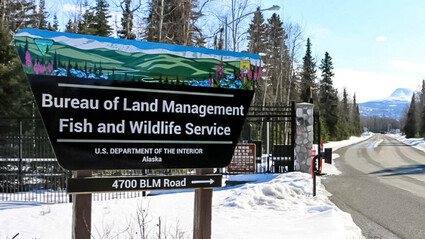The nuts are in charge of the nut house
If President Biden wants to resolve the debt crisis, he might start by reigning in a few of the planners employed by the BLM North of 60 Mining News – June 2, 2023
Last updated 6/1/2023 at 11:40am

Bureau of Land Management
A sign marking the entrance of the Bureau of Land Management's Anchorage District Office. In total, BLM manages more than 70 million acres of public lands in Alaska.
Mark your calendar. June 30, 2023, will be just one more Day in Infamy when catastrophic changes at the hands of the Bureau of Land Management will reach their nadir. (These days, it seems, everything that the government wants to do is "catastrophic!")
On April 3, the BLM promulgated its Conservation and Landscape Health Proposed Rule.
In its own words, the rule would "advance the BLM's mission to manage the public lands for multiple use and sustained yield by prioritizing the health and resilience of ecosystems across those lands. To ensure that health and resilience, the proposed rule provides that the BLM will protect intact landscapes, restore degraded habitat, and make wise management decisions based on science and data."
This opening phrase alone turns the world of public land management upside down. "Protecting" landscapes and restoring habitat is oxymoronic to "wise" decisions based on science and data.
To begin, the BLM "manages" 245 million acres of public lands, 70 million surface acres of which are in Alaska, plus another 150 million acres of subsurface estate. Over 28% of the BLM's area of interest when it comes to landscapes and habitat is in Alaska.
There are over 7,000 federal mining claims in Alaska, whereas there are well over 100,000 state mining claims here.
Granted, the state selected much of its land for the mineral wealth, but the two-thirds of the state that the federal government retained has huge potential as well. The surface and the subsurface that remains under BLM management was thought, at the time of statehood at least, to remain available for mineral entry.
For instance, the General Mining Law said then, and still says, "Except as otherwise provided, all valuable mineral deposits in lands belonging to the United States, both surveyed and unsurveyed, shall be free and open to exploration and purchase, and the lands in which they are found to occupation and purchase, by citizens of the United States and those who have declared their intention to become such, under regulations prescribed by law, and according to the local customs or rules of miners in the several mining districts, so far as the same are applicable and not inconsistent with the laws of the United States." 30 USC 22.
In addition, ANILCA's "no more clause" provides, "No future executive branch action which withdraws more than five thousand acres, in the aggregate, of public lands within the State of Alaska shall be effective except by compliance with this subsection. To the extent authorized by existing law, the President or the Secretary may withdraw public lands in the State of Alaska exceeding five thousand acres in the aggregate, which withdrawal shall not become effective until notice is provided in the Federal Register and to both Houses of Congress. Such withdrawal shall terminate unless Congress passes a joint resolution of approval within one year after the notice of such withdrawal has been submitted to Congress." 13 USC 3212(a)
A recent past state director for the BLM interpreted this language as follows: "What's really important is the "no more clause," or section 1326 of ANILCA. Under the no more clause, it means that we cannot put another conservation system within Alaska, at least over five thousand acres, without the consent of Congress. So, Congress really does have to decide if there are going to be more conservation lands in Alaska. It's not something that the agencies can decide. I think sometimes folks forget about that. But it's a really, really important provision for Alaska." Chad Padget, December 2, 2020.
The BLM's proposed rule makes the outlandish pronouncement that "conservation" is a land "use" within the meaning of the Federal Land Policy and Management Act of 1976.
Accordingly, the rule portends the creation of "conservation leases." By its definition, "conservation" means "maintaining resilient, functioning ecosystems by protecting or restoring natural habitats and ecological functions," and "conservation leases" are to be issued under § 6102.4 of the proposed regulation "for the purpose of restoring, managing, and monitoring areas within priority landscapes."
Nowhere to be found in the proposed regulation is there any limit on the number of conservation leases to be issued or the acreage, or the necessity for contiguity.
Alaska's Statehood Act is not identified in the draft as a relevant consideration. In fact, Alaska is not even mentioned in the proposed regulation. Nor is ANILCA or the Mining Law of 1872.
In brief, this proposed regulation is hostile to virtually everything that Alaska is all about.
It doesn't create jobs. It doesn't promote mining. It doesn't promote logging. It doesn't promote oil and gas development. It doesn't promote fishing. It doesn't even promote tourism. While it does promote consultation under some circumstances with Alaska Natives, it does not promote consultation with the State of Alaska.
In brief, this proposed regulation, if implemented to its fullest extent, will vitiate the economy of the state.
Will the last person out please shut off the lights?














Reader Comments(0)